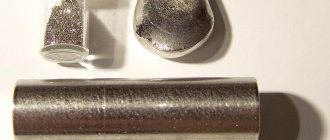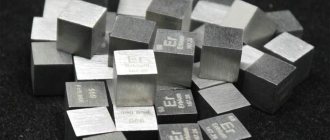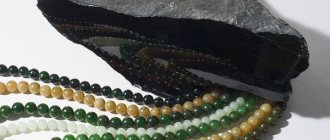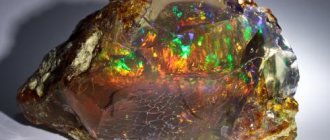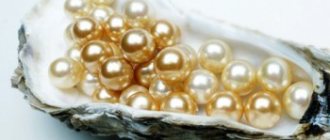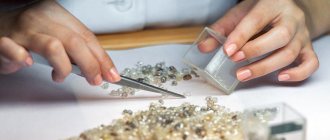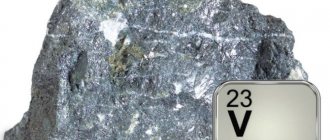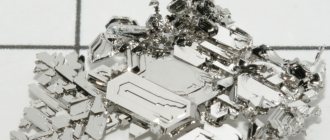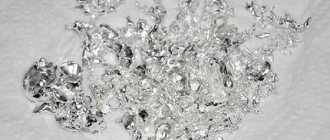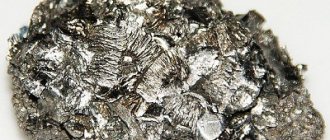Being in nature
The iridium content in the earth's crust is negligible (10−7% by mass). It is much rarer than gold and platinum. It is found together with osmium, rhodium, rhenium and ruthenium. Refers to the least common elements. Iridium is relatively common in meteorites. It is possible that the actual content of the metal on the planet is much higher: its high density and high affinity for iron (siderophilicity) could lead to the displacement of iridium deep into the Earth, into the core of the planet, during its formation from the protoplanetary disk. A small amount of iridium has been discovered in the photosphere of the Sun.
Iridium is found in minerals such as nevyanskite, sysertskite and aurosmiride.
What is
Iridium is a silvery-white shiny metal, a platinum group.
Element of the periodic table number 77, international name – Iridium (Ir).
Very hard (6.5 Mohs), refractory, dense. Resistant to corrosion even at extreme temperatures.
Iridium is one of the two hardest and rarest metals. Its content in the earth's crust is 10 times less than platinum, 40 times less than gold. By weight, this is one millionth of a percent.
He is considered noble by jewelers and financiers.
Iridium mining
Despite the high value of the metal, its quantity on our planet is negligible. Even valuable platinum cannot compete with its rarity. In nature, in the form of nuggets, it is most often found with impurities of other metals, including ruthenium, osmium, palladium or platinum. In combination with these metals, iridium forms aurosmirides, nevyanskites, osmiridium, and sysertskites. Iridium placers can be found in copper and nickel mining areas. It is also possible to extract it from gold deposits.
The leading producing countries are Canada, the USA, South Africa, the island of Tasmania, and New Guinea. The main supplier of iridium to the world market is South Africa.
How much iridium South Africa produces, as well as the rise or fall in demand for the metal, plays a big role in metal mining.
Where is iridium mined?
Mining locations:
- Canada;
- Kalimantan;
- USA;
- SOUTH AFRICA;
- Russia;
- New Guinea.
Occurs naturally in folded areas of peridot serpentinites. Placer deposits are found. Often found in the form of solid solutions in combination with osmium - iridium osmide. According to experts, it is found very rarely in the earth's crust. Therefore, it is believed (in support of the asteroid theory) that the high metal content in ores signals their meteorite origin.
The rarest and richest mineral in iridium is native nevyanskite. It contains more than 11% iridium. Contained in sysertskite, aurosmirid.
Mining locations
The chemical element is found in alloy form in folded earth rocks of the mountains of Russia, peretonite rocks located in South Africa, Kenya, South America, etc.
Where there is platinum, there is also iridium.
About the characteristics of metal as a chemical element:
Characteristic Designation, meaning
| Iridium is represented by the symbol | Ir |
| Number in the periodic table | 77 |
| Atomic weight | 192.22 amu |
| Oxidation states | From 1 to 6 (5 not included) |
| Density at room temperature | 22.7 g/cm^3 |
| Density in liquid state | 19.39 g/cm^3 |
| Melting | At 2300 degrees Celsius |
| Boiling of liquid iridium | At 45 degrees Celsius |
| Has a crystal lattice | Face-centered cube |
The element is found in different colors, the most common is white - KIrF6, lemon - IrF5, gold - K3IrCl6, light green - Na3IrBr6, pink - Cs3IrI6, crimson - Na2IrBr6, dark blue - IrI3. The variety of colors is due to the presence of various salts in iridium.
By the way, the metal got its name due to this variety of colors. Iris is the goddess of the rainbow in Greek mythology.
Receipt
The main source of iridium is anode sludge from copper-nickel production. Au, Pd, Pt, etc. are separated from the concentrate of platinum group metals. The residue containing Ru, Os and Ir is fused with KNO3 and KOH, the melt is leached with water, the solution is oxidized with Cl2, OsO4 and RuO4 are distilled off, and the precipitate containing iridium is fused with Na2O2 and NaOH, the melt is treated with aqua regia and a solution of NH4Cl, precipitating iridium in the form of (NH4)2[IrCl6], which is then calcined to obtain metallic Ir. A promising method for extracting iridium from solutions is the extraction of hexachloroiridates with higher aliphatic amines. The use of ion exchange is promising for separating iridium from base metals. To extract iridium from minerals of the iridium osmide group, the minerals are fused with BaO2, treated with hydrochloric acid and aqua regia, OsO4 is distilled off, and iridium is precipitated in the form of (NH4)2[IrCl6].
How to mine iridium
Every year all miners on Earth receive from 3 to 10 tons (according to various sources).
The problem with iridium mining is the large losses of metal during ore processing. After all, there are almost no pure iridium ores that allow industrial extraction of iridium. The main part of the metal is mined by processing copper-nickel ores, where the satellites are platinum group metals.
The metal is mainly obtained from copper-nickel ore sludge. During their extraction, platinum group metals end up in process solutions and production waste.
The technology for extracting iridium (like other platinum group metals) consists of several stages of extracting these metals. This includes concentration, treatment with alkalis, and removal of impurities.
Properties of iridium
The physical properties of iridium are quite impressive. It is a very hard, heavy metal that is difficult to machine. The melting point is 24660C, and has a fairly high boiling point of 44280C. Its hardness is determined by its density - 22.65 g/cm3. It is stable when heated and at ordinary temperatures; at temperatures up to 1000C it does not react to all known acids. In the presence of alkali metal chlorides at temperatures of 600-9000C, iridium powder can be dissolved by chlorination. It interacts with F2 when the temperature reaches 4500C. The properties of iridium do not play any biological role; it is not a toxic metal, although some of its compounds are very poisonous.
Iridium indicators:
- alloys of iridium with tungsten and thorium are used as metal for thermoelectric generators; with other metals they make fuel tanks for spacecraft, thermocouples, and thermionic cathodes;
- in the automotive industry they are used in spark plugs, which allows them to be used for a long time, although they are expensive;
- finds its application in the manufacture of nibs for ink pens, on gold nibs;
- iridium-192 is successfully used in flaw detection, where generating sources cannot be used, for example, in an explosive environment;
- It is interesting that the kilogram standard is made from iridium, since the alloy of iridium with platinum has mechanical strength and does not oxidize;
- is used in the jewelry industry, but the price for such jewelry is incredibly high;
- make laboratory crucibles to conduct experiments with fluorine, as well as its aggressive compounds;
- make highly durable, heat-resistant glass blowing mouthpieces.
Where is iridium used?
Until recently, the noble metal with unique properties was treated with great caution. But just 70 years later, the scope of iridium has expanded significantly - now it is used not only in the chemical industry, but also in jewelry and other modern industries.
For example, in the manufacture of spark plugs, jet engines, electric lamps, heat-resistant tableware, refractory glass, surgical instruments, etc.
Iridium jewelry is already available for sale
Iridium is used to create crucibles in which single crystals for laser are grown. Due to chemical inertness and extremely high melting point, such a container does not react with the contents placed in it, which allows the production of high quality products.
Valuable iridium is included in some advanced medications that help fight the development of cancer tumors in the human body, thanks to its special radioactive isotopes. Nuclear physicists see them as a powerful potential source of electricity in the near future.
Wherever iridium is used, even in small quantities, it always serves without fail. Therefore, we can safely say that the science and industry of the future will not do without it.
Physical properties
Iridium is a heavy, silvery-white metal that, due to its hardness, is difficult to machine. Melting point - 2739 K (2466 °C), boils at 4701 K (4428 °C). The crystal structure is face-centered cubic with a period a0=0.38387 nm; electrical resistance - 5.3⋅10−8 Ohm m (at 0 °C), and 2⋅10−7 Ohm m (at 2300 °C); coefficient of linear expansion - 6.5⋅10−6 degrees; normal elastic modulus - 538 GPa; density at 20 °C - 22.65 g/cm³, liquid iridium - 19.39 g/cm³ (2466 °C).
Isotopic composition
Natural iridium occurs as a mixture of two stable isotopes: 191Ir (content 37.3%) and 193Ir (62.7%). Radioactive isotopes of iridium with mass numbers 164-199, as well as many nuclear isomers, have been obtained by artificial methods. Artificial 192Ir has become widespread.
Chemical and physical properties
Iridium is a metal that is hard and brittle at the same time.
Iridium crystals
Chemical and physical properties:
- It has a high density - up to 22650 kg/m3.
- The oxidation state in compounds is most often +3, +4, rarely +1, +2, +5 and +6.
- Melting point 2466 °C.
- Iridium begins to boil at 4428 °C.
- Chemically resistant metal (under normal conditions); does not react with alkalis and acids, even with aqua regia.
- The metal color is silver-white.
When heated, it reacts with halogens (fluorine, chlorine, bromine) and oxygen.
| Properties of the atom | |
| Name, symbol, number | Iridium / Iridium (Ir), 77 |
| Atomic mass (molar mass) | 192.217(3)[1] a. e.m. (g/mol) |
| Electronic configuration | [Xe] 4f14 5d7 6s2 |
| Atomic radius | 136 pm |
| Chemical properties | |
| Covalent radius | 127 pm |
| Ion radius | (+4e) 68 pm |
| Electronegativity | 2.20 (Pauling scale) |
| Electrode potential | Ir←Ir3+ 1.00 V |
| Oxidation states | 9, 7, 8, 6, 4, 3, 2, 1, 0, −1, −3 |
| Ionization energy (first electron) | 868.1 (9.00) kJ/mol (eV) |
| Thermodynamic properties of a simple substance | |
| Density (at normal conditions) | 22.65/22.56±0.01[2][3][4] g/cm³ |
| Melting temperature | 2739 K (2466 °C, 4471 °F)[2] |
| Boiling temperature | 4701 K (4428 °C, 8002 °F)[2] |
| Ud. heat of fusion | 26.0 kJ/mol |
| Ud. heat of vaporization | 610 kJ/mol |
| Molar heat capacity | 25.1[5] J/(K mol) |
| Molar volume | 8.54 cm³/mol |
| Crystal lattice of a simple substance | |
| Lattice structure | cubic face-centered |
| Lattice parameters | 3.840 Å |
| Debye temperature | 430.00 K |
| Other characteristics | |
| Thermal conductivity | (300 K) 147 W/(m K) |
| CAS number | 7439-88-5 |
We recommend: COBALT - a generous gift from mountain spirits
The crystal lattice is face-centered, cubic.
Chemical properties
Iridium is stable in air at ordinary temperatures and heating; when the powder is calcined in a stream of oxygen at 600–1000 °C, it forms a small amount of IrO2. Above 1200 °C it partially evaporates in the form of IrO3. Compact iridium does not react with all known acids and their mixtures at temperatures up to 100 °C. Freshly precipitated iridium black partially dissolves in aqua regia to form a mixture of Ir(III) and Ir(IV) compounds. Iridium powder can be dissolved by chlorination in the presence of alkali metal chlorides at 600–900 °C or by sintering with Na2O2 or BaO2 followed by dissolution in acids. Iridium interacts with F2 at 400–450 °C, and with Cl2 and S at red heat.
Oxidation state of iridium
Iridium atoms in compounds have oxidation states of 6, 5, 4, 3, 2, 1, 0, -1.
The oxidation state is the conditional charge of an atom in a compound: the bond in a molecule between atoms is based on the sharing of electrons, thus, if an atom’s charge virtually increases, then the oxidation state is negative (electrons carry a negative charge), if the charge decreases, then the oxidation state is positive.
Iridium ions
6+Ir 5+Ir 4+Ir 3+Ir 2+Ir 1+Ir
Ir 01-Ir
Valency Ir
Iridium atoms in compounds exhibit valence VI, V, IV, III, II, I.
The valency of iridium characterizes the ability of the Ir atom to form chemical bonds. Valence follows from the structure of the electron shell of the atom; electrons involved in the formation of chemical compounds are called valence electrons. A more extensive definition of valence is:
The number of chemical bonds by which a given atom is connected to other atoms
Valence has no sign.
Quantum numbers Ir
Quantum numbers are determined by the last electron in the configuration; for the Ir atom these numbers have the value N = 5, L = 2, Ml = -1, Ms = -½
Trivalent iridium compounds
- Ir2O3 is a dark blue solid. Slightly soluble in water and ethanol. Dissolves in sulfuric acid. It is obtained by lightly calcining iridium(III) sulfide.
- IrCl3 is an olive green volatile compound. Density - 5.30 g/cm³. Slightly soluble in water, alkalis and acids. At 765 °C it decomposes into IrCl2 and chlorine, at 773 °C into IrCl and chlorine, and above 798 °C into its constituent elements. It is obtained by the action of chlorine on iridium heated to 600 °C.
- IrBr3 - olive green crystals. Soluble in water, slightly soluble in alcohol. Dehydrates when heated to 105-120 °C. When heated strongly, it decomposes into elements. Prepared by reacting IrO2 with hydrobromic acid.
- Ir2S3 is a brown solid. Decomposes into elements when heated above 1050 °C. Slightly soluble in water. Dissolves in nitric acid and potassium sulfide solution. It is obtained by the action of hydrogen sulfide on iridium (III) chloride or by heating powdered metal iridium with sulfur at a temperature not exceeding 1050 °C in a vacuum.
Quadrivalent iridium compounds
- IrO2 are black tetragonal crystals with a rutile-type lattice. Density - 3.15 g/cm³. Slightly soluble in water, ethanol and acids. Reduced to metal by hydrogen. Thermally dissociates into elements when heated. It is obtained by heating powdered iridium in air or oxygen at 700 °C, heating IrO2*nH2O.
- IrF4 is a yellow oily liquid that decomposes in air and is hydrolyzed by water. melting point 106 °C. Prepared by heating IrF6 with iridium powder at 150 °C.
- IrCl4 is a hygroscopic brown solid. It dissolves in cold water and decomposes with warm (water). It is obtained by heating (600–700 °C) metallic iridium with chlorine at elevated pressure.
- IrBr4 is a blue substance that diffuses in air. Soluble in ethanol; in water (with decomposition), dissociates when heated into elements. It is obtained by reacting IrO2 with hydrobromic acid at low temperature.
- IrS2 is a brown solid. Slightly soluble in water. It is obtained by passing hydrogen sulfide through solutions of iridium (IV) salts or by heating powdered metal iridium with sulfur without access of air in a vacuum.
Hexavalent iridium compounds
- IrF6 - yellow tetragonal crystals. melting point 44 °C, boiling point 53 °C, density - 6.0 g/cm³. Under the influence of metallic iridium it turns into IrF4, and is reduced by hydrogen to metallic iridium. It is produced by heating iridium in a fluorine atmosphere in a fluorite tube. A very strong oxidizing agent that can oxidize even water:
2IrF6 + 10H2O = 2Ir(OH)4 + 12HF + O2, or NO: NO + IrF6 = NO+[IrF6]-
- IrS3 is a gray, slightly water-soluble powder. It is obtained by heating powdered metal iridium with excess sulfur in a vacuum. Strictly speaking. is not a compound of hexavalent iridium, since it contains an SS bond.
- Ir(OH)4 (IrO2*2H2O) is formed by neutralizing solutions of chloroiridates(IV) in the presence of oxidizing agents. The precipitate Ir2O3*nH2O precipitates when chloroiridates (III) are neutralized with alkali and is easily oxidized in air to IrO2. Practically insoluble in water.
Rainbow metal
The metal was discovered and given its name by the Englishman S. Tennant, a chemist. While conducting experiments with native platinum, the chemist also examined the solutions remaining from the experiments. And not in vain - in them he discovered multi-colored salts of an unknown element.
Iridium was named after the rainbow (in Greek iris) - a multi-colored miracle.
This is not about the color of the metal, it is about the variety of colors of iridium salts:
- K3IrCl6, IrF6 - golden yellow crystals;
- KIrF6 - white crystals;
- Ir2O3 - blue, blue-black crystals:
- IrCl2 - green crystals;
- Na2IrBr6 - crimson color.
There are iridium compounds colored olive, brown, pink, and golden.
Peculiarities
It’s worth saying right away that iridium is a metal. Therefore, it has all those properties that are typical of other metals. Such a chemical element is designated by a combination of the Latin symbols Ir. In the periodic table it occupies the 77th cell. The discovery of iridium occurred in 1803, as part of the same research in which the English scientist Tennant isolated osmium.
The starting material for the production of such elements was platinum ore delivered from South America. Initially, the metals were isolated in the form of a sediment, which “regia vodka” did not “take.” The study revealed the presence of several previously unknown substances. The element received its verbal designation because its salts look as if they shimmer with a rainbow.
The content of iridium in nature is extremely low, and it is one of the rarest substances on Earth.
Chemically pure iridium does not have any rainbow color. But it is characterized by a rather attractive silver-white color. Toxic properties have not been confirmed. However, certain iridium compounds can pose a danger to humans. Fluoride of this element is especially poisonous.
A number of Russian and foreign enterprises are engaged in the production and refining of iridium. Almost the entire output of this metal is a by-product of processing platinum raw materials. Although iridium is not purple, it contains 2 isotopes naturally. Elements 191 and 193 are stable. But a number of artificially produced isotopes have pronounced radioactive properties; their half-life is short.
Rainbow metal
The discovery of iridium dates back to 1803, when it was obtained in sufficient quantities for identification. The English chemist S. Tennant treated South American natural platinum with aqua regia (a freshly prepared mixture of nitric and hydrochloric acids). In the collected insoluble sediment, previously unknown metals were discovered, one of which was iridium.
The newly discovered metal manifests itself in compounds as two, three, four and hexavalent elements. The substances that are formed have a wide color palette. Their color varies from bright yellow to dark blue and black. It is because of this property that iridium got its name. Translated from ancient Greek, ἶρις means “rainbow”.
Application
Of particular interest as a source of electricity is its nuclear isomer, iridium-192m2 (half-life 241 years).
Alloys with W and Th are materials for thermoelectric generators, with Hf are materials for fuel tanks in spacecraft, with Rh, Re, W are materials for thermocouples operated above 2000 °C, with La and Ce are materials for thermionic cathodes.
Iridium is also used to make pen nibs. A small ball of iridium can be found on the tips of nibs and ink rods, and is especially visible on gold nibs, where it is a different color from the nib itself.
Iridium in paleontology and geology is an indicator of the layer that formed immediately after the fall of meteorites.
Iridium, along with copper and platinum, is used in spark plugs of internal combustion engines (ICE) as a material for the manufacture of electrodes, making such plugs the most durable (100-160 thousand km of vehicle mileage) and reducing the requirements for sparking voltage. The first company to use iridium, thereby improving the quality of spark plugs, was the Japanese company NGK. Initially used in aviation and racing cars, then, as the cost of production decreased, it began to be used in mass-produced cars. Currently, such spark plugs are available for most engines, but are the most expensive.
Iridium-192 is a radionuclide with a half-life of 74 days, widely used in flaw detection, especially in conditions where generating sources cannot be used (explosive environments, lack of supply voltage of the required power).
Platinum-iridium alloy has great mechanical strength and does not oxidize. In particular, the kilogram standard is made from this alloy.
In 2013, iridium was used for the first time in the world in the production of official coins by the National Bank of Rwanda, which issued a coin made of pure metal of 999 purity. An iridium coin was issued in the denomination of 10 Rwandan francs.
Industry
The properties of the metal determined the areas of application in the industrial complex:
- Iridium is used to make dishes, equipment, and catalysts for chemical enterprises.
- Single crystals are grown in iridium crucibles.
- In the automotive industry, this is the material of the electrodes (with copper and platinum) of spark plugs. They last longer and are used for luxury cars.
- Iridium-ruthenium alloys contain electric generators and thermocouples for measuring temperatures up to 2000°C.
- This is an indicator of the quality of welds made of steel and aluminum alloys.
The kilogram and meter standards are made from a platinum-iridium alloy (located in Paris).
The third millennium opened up space prospects:
- American Elements has created a technology for casting seamless iridium rings for use on satellites and spacecraft (2006).
- Metal is present in the displays of computers, televisions, iPhones, and other gadgets based on organic light-emitting diodes (OLED technology).
The nuclear isomer of iridium-192 with a “lifetime” of more than 240 years is considered as an energy source.
Medicine
Surgical instruments and parts of pacemakers are made from an alloy of platinum and iridium.
This is the basis for the development of nuclear medicine. Radionuclide raw materials are produced in nuclear reactors and cyclotrons. 90% goes for export.
Russia is one of the world's top five producers of raw medical isotopes.
Iridium-192 is used in flaw detection and oncologists (gamma knife).
Fabulous prospects for iridium in medicine
Pacemakers use an iridium-platinum alloy.
Oncologists use the iridium isotope Ir-192 as a source of gamma radiation. It is used to treat breast and prostate cancer (in the early stages of the disease).
Methods have been developed for the treatment of epilepsy, Parkinson's disease, and schizophrenia by introducing iridium electrodes into the brain. The method of implanting microelectrodes opens up bright prospects for creating prosthetic eyes and hearing aids.
Jewelry
Jewelers value the metal for its strength, using it in an alloy with platinum.
The American company Smithson Tennant was the first to launch the production of iridium jewelry. Iridium wedding rings are positioned by her as eternal in the literal sense: even concentrated acid and time are powerless. They do not require special care or storage conditions.
Jewelry made from alloys with the addition of iridium still looks like it was just purchased after decades.
Jewelry with iridium (even wedding rings) does not wear out and always looks like new. This advantage is especially important for products that experience increased loads (wedding rings, rings, bracelets).
Other areas
Iridium is revered by geologists and paleontologists: it is a marker of the age of layers of the earth's crust and extinct organisms.
The only coin in the world - iridium fineness 999 - was issued in 2013 by the National Bank of Rwanda (a state in eastern Africa). The denomination was 10 local francs.
Until the 1980s, iridium alloy balls were found in the nibs of luxury fountain pens, including the legendary Parker 51. It is an attribute of the elite and an accessory for the luxury fan of James Bond.
Biological role
Does not play any biological role. Iridium metal is non-poisonous, but some iridium compounds, such as its hexafluoride (IrF6), are very poisonous.
Iridium - element 77 of the periodic table
The atomic mass of element No. 77 is 192.2. In the periodic table it is located between osmium and platinum. And in nature it is found mainly in the form of iridium osmide, a frequent companion of native platinum. There is no native iridium in nature.
Iridium is a silvery-white metal that is very hard, heavy and durable. According to the data, this is the heaviest element: its density is 22.65 g/cm3, and the density of its constant companion, osmium, the second heaviest, is 22.61 g/cm3. True, most researchers adhere to a different point of view: they believe that iridium is still a little lighter than osmium.
The natural property of iridium (aka platinoid!) is high corrosion resistance. It is not affected by acids either at normal or at elevated temperatures. Even the famous aqua regia is too tough for monolithic iridium. Only molten alkalis and sodium peroxide cause oxidation of element No. 77.
Iridium is resistant to halogens. It reacts with them with great difficulty and only at elevated temperatures. Chlorine forms four chlorides with iridium: IrCl, IrCl2, IrCl3 and IrCl4. Iridium trichloride is most easily obtained from iridium powder placed in a stream of chlorine at 600°C. The only halide compound in which iridium is hexavalent is fluoride IrF6. Finely ground iridium is oxidized at 1000°C and in a stream of oxygen, and depending on the conditions, several compounds of different compositions can be obtained.
Like all platinum group metals, iridium forms complex salts. Among them there are also salts with complex cations, for example [Ir(NH3)6]Cl3 and salts with complex anions, for example K3[IrCl3] · 3H2O. As a complexing agent, iridium is similar to its neighbors on the periodic table.
Pure iridium is obtained from native osmic iridium and from the remains of platinum ores (after platinum, osmium, palladium and ruthenium have been extracted from them). We will not dwell on the technology for producing iridium, referring the reader to the articles “Rhodium”, “Osmium” and “Platinum”.
Iridium is obtained in the form of a powder, which is then pressed into semi-finished products and fused, or the powder is melted in electric furnaces in an argon atmosphere. Pure iridium can be forged when hot, but at normal temperatures it is brittle and cannot be processed in any way.
Extraction and processing
The main volumes of iridium are extracted from sulfate ferrous and nickel ores. Mineralogical exotics provide a little - nevyanskite, urosmiride, sysertskite.
Pure iridium is obtained industrially from the products of processing copper-nickel alloys.
The technology is multi-stage - isolation of platinum group metals from the concentrate, leaching of the residue with water, distillation, exposure to aqua regia. Sedimentary iridium is calcined to obtain pure metal.
There are other methods: ion exchange, extraction. All production technologies are complex and costly.
In Russia, iridium is mined by enterprises in Krasnoyarsk, Yekaterinburg, and Norilsk Nickel.
Artificial iridium
Iridium, like many other metals, is an extremely rare, but very valuable and widely used metal. The demand for such metals is only growing, but their quantity in nature is decreasing and, to the great regret of mankind, is not being renewed. In this regard, the artificial synthesis of precious metals is gaining momentum in the world. Entire companies and laboratories are being created for this purpose. The most advanced and successful technology for the artificial synthesis of precious metals, which is just beginning to be introduced, is cold nuclear transmutation. This method is recognized throughout the world and today it is used to synthesize artificial platinum. Work is underway on the remaining metals. On the territory of Russia he is engaged in artificial synthesis.
How is iridium produced?
Iridium is used to coat product surfaces. A method has been developed for producing iridium coatings electrolytically from molten potassium and sodium cyanides at 600°C. In this case, a dense coating up to 0.08 mm thick is formed.
Interesting materials:
Which countries boycotted the Moscow Olympics? Which countries produce the most films? Which countries were colonies of France? Which countries were colonies of Great Britain? Which countries were captured by Germany? What countries make whiskey? Which European countries do not change their clocks? Which countries say salam aleikum? Which countries spoke Latin? Which countries border the Aegean Sea?
Interesting Facts
Iridium salts are very diverse in color. Thus, depending on the number of added chlorine atoms, the compound may have a copper-red, dark green, olive or brown color. Iridium difluoride is yellow in color. Compounds with ozone and bromine are blue in color. Pure iridium has very high corrosion resistance even when heated to 2000 degrees.
In rocks of terrestrial origin, the concentration of iridium compounds is very low . It seriously increases only in rocks of meteorite origin. This criterion allows researchers to establish important facts about various geological structures. Only a few tons of iridium are produced on earth.
The Young's modulus (also known as the longitudinal elastic modulus) of this metal is in second place among known substances (only graphene has more).
Sources
- https://chem.ru/iridij.html
- https://mysamocvet.ru/metally/iridij/
- https://ProDragmetally.ru/dragotsennye-metally/iridij.html
- https://himsnab-spb.ru/article/ps/ir/
- https://metallsmaster.ru/iridij/
- https://k-tree.ru/tools/chemistry/periodic.php?element=Ir
- https://TheMineral.ru/metally/iridij
- https://vplate.ru/metally-i-splavy/vse-ob-iridii/
- https://jgems.ru/metally/iridij
- https://calcsbox.com/post/iridium.html
